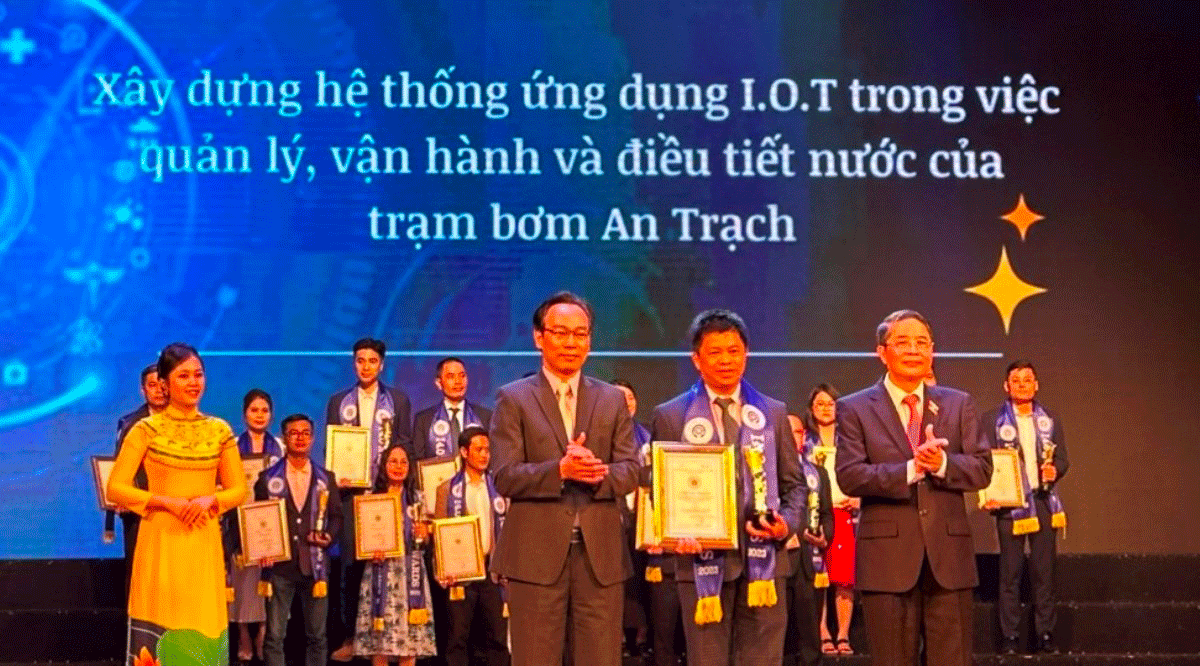Smart irrigation control for rice cultivation
According to local farmers in An Trach Village, "smart agriculture is not far away; it is present right in our rice fields". Many farmers in Hoa Tien Commune, Hoa Vang District proudly spoke about the automatic water level measuring poles in their fields and the automatic sluice gates nearby, powered by solar panels to manage irrigation for their rice crops. Some even mentioned how they could monitor water levels in real time through a smartphone application and control the opening and closing of the sluice gates accordingly.
 |
| Leaders of the Viet Nam Union of Scientific and Technological Associations awarded a Certificate recognising the NetPlus Joint Stock Company for its smart digital products and Industry 4.0 technological solutions. |
Since 2021, the Da Nang Department of Agriculture and Rural Development has asked the Irrigation Sub-Department to collaborate with the Da Nang Irrigation Exploitation Company to implement an IoT technology model for managing and regulating irrigation at the An Trach irrigation station, developed by NetPlus. This initiative aims to minimise water loss during irrigation, reduce operational labour costs, and modernise the irrigation system to enhance flexibility.
In the first phase in 2021, the involved parties invested in software, management devices, and irrigation control systems from the An Trach pumping station into various channels and rice fields. This included one wireless technology station and data transmission system (Lora gateway), six water level monitoring devices, and five automatic water intake gates.
This system, installed in the first phase, was used by staff from the An Trach irrigation station under the Da Nang Irrigation Exploitation Company and Hoa Tien 2 Cooperative to manage irrigation for an initial area of three hectares. This was achieved through sluice gates controlled either by electrical buttons or the dedicated software.
The system quickly proved effective, facilitating convenient water level monitoring in the fields and allowing for the efficient regulation of water supply for the rice. It saved both time and labour, shortening irrigation periods by up to a day for each session and preventing farmers' indiscriminate flooding of fields.
In 2022, the system was enhanced with management features in the software and operational devices. The water level measurement devices installed on the main and first tiers enabled better monitoring and control of water volume and stability.
Using the software, smartphones, and electromechanical components, staff regulated the sluice gates on the main channel and the inlet gates to distribute water appropriately across the branch channels as needed, further reducing irrigation times compared to previous methods.
 |
| The staff at the NetPlus Joint Stock Company regularly monitor and adjust the IoT technology application software used for managing and regulating irrigation at the An Trach irrigation station. Photo: HOANG HIEP. |
According to Mr Pham Cong Tuan, Director of Hoa Tien 2 Cooperative, nearly 40 hectares of rice cultivated by cooperative members in the An Trach Village now utilise IoT technology for irrigation management. When the water level sensor indicates a reading of 5cm or 7cm (depending on the rice growth stage), the automated system closes the sluice gate to stop water inflow.
However, some unexpected situations still arise that require managerial oversight to adjust operational schedules and irrigation plans accordingly. For instance, in areas where the terrain is uneven, the required water level may not be reached. In such cases, if they are on-site, they can manually open the sluice gate to allow water into higher areas for additional irrigation. If they are away, they can control the sluice gate via their smartphones. This system significantly saves water and reduces costs and labour while ensuring optimal irrigation levels, thereby enhancing rice yield and quality.
Mr Duong Van Tuan, Director of NetPlus Joint Stock Company, noted that the implementation of this technological model for managing irrigation at the An Trach station had successfully adhered to the dry-wet irrigation method, resulting in various production, economic, and environmental benefits while reducing greenhouse gas emissions.
With these initial successes, in 2023, the company received certification from the Viet Nam Union of Scientific and Technological Associations for its smart digital products and Industry 4.0 technological solutions. The company is proposing further development of the irrigation system software and the installation of additional automatic sluice gates along the main channels.
Simultaneously, they aim to install devices to monitor the salinity of the Yen River water and an automated system for opening and closing sluice gates at the Duong Son and Mieu Ong pumping stations to ensure that saline water is not mistakenly pumped into the rice fields.
Mr Le Van Tuyen, Head of the Irrigation Sub-department under the Department of Agriculture and Rural Development, indicated that the involved units and localities are currently analysing and evaluating the technological model for managing and regulating irrigation water, proposing effective and suitable implementation strategies.
Reporting by HOANG HIEP - Translating by TRUC VY